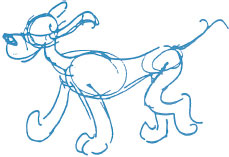25 Construction Observations Useful in Animation
Humans, most animals, and to a degree cartoon characters are constructed on a solid-flexible, solid-flexible basis:

A cartoon character is more flexile, but the principle of solid-flexible is applicable because all the same parts are there — they are merely caricatured.

The solid and flexible parts of a character’s head can be used to great advantage in animation; for instance in dialog or in an open mouth stretch:

The stretch will mean more if you can first give some sense of the normal; for instance if you first show the dog in his normal pose, then squashed it for anticipation:

Then the audience really feels the stretch when it comes. For the sake of illustration, say you start with a stretch drawing, the impact will not be as great. As a matter of fact if the viewer is not familiar with the character, he might think that the wide-open mouth is his norm. That may be stretching the point a little but it illustrates a valuable principle of animation: squash and stretch.
Even though considering the skull part of the head to be the solid, that doesn’t mean the surface features need to be frozen to that shape. An expression where the eyes open wide and the jaw drops can send the eyebrows sky high on the brow. The lines under the eyes can drop way down below normal, pulled down by the jaw action. This happens nearly every time something is stretched. You might say, nothing ever happens without influencing something else. The closer the “something else” is to the primary action, the more it will be influenced. For instance let’s take a row of lines:
![]()
And pull the one on the right to the right:
![]()
In searching out ways to use the principles of animation such as squash and stretch, one should think of animating an object or character rather than merely moving it. Even in your mind’s eye, there is a difference between looking at an action as opposed to seeing an action, or in other words, watching an action as opposed to experiencing an action. In the book Inner Tennis the author speaks about “riding the ball.” It is a psychological think — it causes one to think of taking part in the hitting of the ball and in its flight — as opposed to just hitting the ball and letting it go anywhere it pleases. These are all just different ways of saying, in true Zen fashion, animate the action as if you were it.
